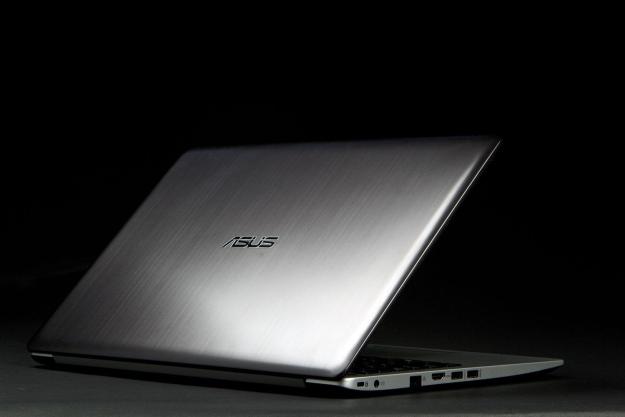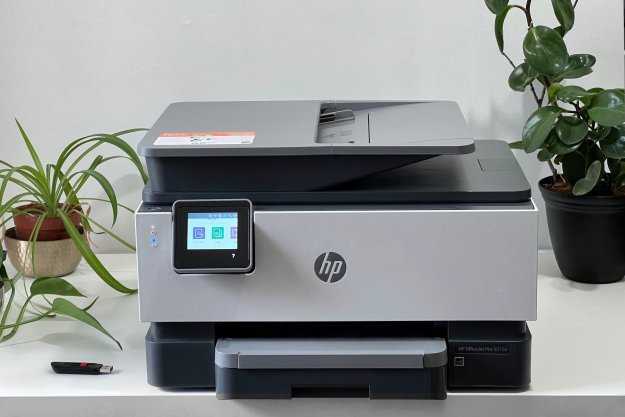
“Asus’s VivoBook V551LB may look pretty, but with battery life that’s as impressive as its screen is disappointing, and no solid-state storage, this Ultrabook feels more than a little unbalanced, especially considering its high price.”
- Very impressive battery life, especially under heavy load
- Solid-feeling, nice-looking design
- Runs quiet and cool
- Better gaming performance than most Ultrabooks
- Sub-par, low-resolution display
- No solid-state storage
- Keyboard is not backlit
- Quiet speakers
- Not a great value
Since Intel began pushing the Ultrabook form factor back in 2012, standard laptop designs have mostly diverged into two camps. On one side, you have the ultra-slim, premium machines, like Acer’s S7, which usually ditch the optical drive in favor of light weight and high-end features. On the opposite bank sits the more traditional, bulkier, but lower-priced systems like Lenovo’s Y480, with lower-quality screens and often annoyingly slow hard drives.
Asus’ VivoBook line of touch-enabled
In the updated VivoBook V551LB-DB71T model we’re looking at here, Asus outfits it with a new Intel 4th-gen (Haswell) CPU and fresh mid-range Nvidia GT 740M graphics that give the system more pixel-pushing power than its predecessor, which relied on integrated graphics.
But the new components push the price up from the modest $700 of its predecessor, into the more premium Ultrabook territory of $980. Is a new chip generation and improved graphics worth the extra dough? Let’s find out.
A nicely balanced exterior design
The VivoBook V551LB-DB71T is far from the slimmest system we’ve seen, but at 0.9 inches, it’s reasonably thin for a 15-inch laptop. And at just under an inch, it still manages to make room for both a DVD drive and the dedicated Nvidia graphics.
The shell is mostly metal and has a nice brushed-aluminum lid reminiscent of the company’s high-end ZenBooks. It’s textured plastic bottom is a nice touch, and doesn’t feel cheap.
Overall, the VivoBook looks and feels like a premium, well-built machine, although at 5.3 pounds, it’s also fairly hefty. That being said, Sony’s similarly sized Vaio T Series Touch Ultrabook is only slightly lighter, at 5.2 pounds, without the dedicated graphics.
Mostly improved ports
Asus switched up the port selection a bit from the previous model. The VGA port is gone, but you get two USB 3.0 ports this time on the left edge, along with HDMI and Ethernet. The right edge houses a USB 2.0 port, an SD card slot, the headphone/mic jack, and the tray-loading DVD drive.
We’d prefer that all USB ports be 3.0 at this point. But for most people, a pair of speedy peripheral ports is probably enough. And unless you often connect to older projectors, you probably won’t miss VGA.
Somewhat imperfect input
We found the VivoBook’s keyboard and touchpad to be okay, but not great. Asus rejiggered the key layout from the previous model we looked at, and though it still feels mostly roomy, the arrow keys are smaller and the number pad still feels a bit cramped.

There’s a decent amount of key travel for an Ultrabook, but it seems like they could be less shallow, given that the laptop is nearly an inch thick. And there’s no backlight here, which is a letdown for a modern laptop in this price range.
Just like we saw with the S550CA, the touchpad is roomy and handles multitouch gestures well. It’s a bit too sensitive out of the box, at least for our fingers, so you’ll probably want to jump into the settings and dial things down a couple of notches. We like that the touchpad is nearly flush with the wrist area, which makes it easy to swipe in from the sides to bring up Windows 8 menus.
Display dismay
The good news is that, like other VivoBooks, the V551LB-DB71T has edge-to-edge glass and a responsive touchscreen that works well for tapping an occasional link or button, or for swiping in from the right edge to bring up the Windows 8 Charms Bar.
740M graphics may be mid range, but they’re plenty powerful enough to handle today’s games…
The bad news is, well, pretty much everything else about the display. While its 1,366 x 768 resolution is okay for a budget system, it’s disappointing on a 15.6-inch LCD in a system that’s priced close to $1,000. Sony has mostly shifted to 1080p displays, even in mid-range
Lackluster resolution isn’t the screen’s only issue, either. In our testing, the panel was only able to reproduce 55 percent of the sRGB scale, a result that’s well below average. The VivoBook’s contrast and black level scores are also worse than most other
All that being said, while the screen’s vertical viewing angles are fairly narrow, horizontally, they’re pretty good. But reflection issues from the glossy glass are also a problem, which isn’t helped by a maximum brightness that’s also sub-par for systems in this price range.

Overall, the screen’s performance was fairly similar to what we saw with the VivoBook S550CA. And while we weren’t happy with the screen on that $720 system, we’re more disappointed here, when the price is a fair bit higher.
There’s no reprieve for the VivoBook when it comes to audio, either. The pair of downward-firing speakers that sit on the bottom of the laptop, near the front edge, are free of
Cool, quiet operator
While the VivoBook’s display doesn’t impress, its cooling abilities are another matter. Whether under full load or sitting idle, the system refused to register a sound above our 40-decibel baseline. There was some very light fan noise when maxing out the machine, particularly when pushing the graphics in FurMark, but it’s barely noticeable unless you’re alone in a very quiet place.
Temperatures were similarly pleasing. When maxing out the CPU, the VivoBook topped out at 91.2 degrees Fahrenheit on the bottom back of the laptop. Things got a bit warmer when leaning heavily on the graphics, but temperatures still topped out at 95 degrees, which isn’t uncomfortably warm.
Considering its sub-inch-thick frame and the inclusion of dedicated Nvidia graphics, the VivoBook is impressively quiet and cool.
Ho-hum hard drive
The V551LB has a lineup of mostly solid, fairly new components, including a 4th-gen (Haswell) processor, a generous 8GB of RAM, and a recent, though mid-range Nvidia GT 750M graphics chip.

When it comes to storage, however, the system has a 1TB hard drive, without even a small amount of solid-state cache. SSD cache has become fairly common at this point in Ultrabooks that can often be found for hundreds less, and can significantly cut boot times and the loading times of frequently used apps.
That being said, the system still booted up in about 15 seconds and never felt sluggish in our anecdotal testing. So it seems, at least, that Asus didn’t slap a slow hard drive in the VivoBook.
Mostly impressive performance
With its 1.8GHz Intel Core i7-4500U CPU and fairly new dedicated Nvidia graphics, the VivoBook mostly outpaced recent Ultrabooks like Acer’s updated S7 in our benchmarks. In the SiSoft Sandra Processor Arithmetic test, the VivoBook’s score of 39.82 GOPS easily surpassed the Acer S7’s score of 33.74.
… its 1,366 x 768 resolution is… disappointing on a 15.6 inch LCD in a system that’s priced close to $1,000.
Dedicated graphics gives the VivoBook a boost on 3DMark’s demanding Fire Strike benchmark, where it scored 912. Acer’s S7, with its Intel integrated graphics, mustered up a score of 664 on the same test. The VivoBook’s 740M graphics may be mid-range, but they’re plenty powerful enough to handle today’s games, especially at the screen’s low-end resolution.
In PCMark 7, however, which measures a machine’s overall performance capabilities, the VivoBook falters, scoring just 3184 to the Acer S7’s 5058. PCMark weighs fast solid-state storage very heavily, arguably with good reason, as it can make a big difference in perceived speed. And the VivoBook’s traditional hard drive can’t keep up with the SSD in Acer’s Ultrabook.
Battery bliss
The VivoBook’s main saving grace is its battery life. Whether it’s the new, more efficient Haswell CPU, or a better, bigger battery (or likely a combination of both), this VivoBook lasted a seriously impressive 4 hours and 26 minutes in our demanding Battery Eater test. That’s roughly 2.5 times the longevity of the VivoBook S550CA that we looked at about four months ago, and one of the best scores we’ve ever seen from laptop without a second or extended battery.

The V551LB also lasted a minute over 7 hours on our less-demanding Reader test. That score’s not as impressive, but still better than average, especially for a thin system.
That being said, we’re still in the fairly early stages of the rollout of Haswell-equipped
Conclusion
The VivoBook V551LB is a mixed bag of highs and lows, with very good battery life, but a sub-par screen. It has a mostly premium-feeling shell, but lacks the solid-state storage or backlit keyboard that we’ve come to expect with a system priced at near $1,000.
That doesn’t make the VivoBook a bad option by any means. It’s just not the best-balanced choice for most users. If you value battery life, some gaming prowess, a nice-looking exterior, and silent operation over super-fast boot times and a well-performing, high-resolution screen, the V551LB should suit you nicely.
You may want to wait to see if the price drops a bit, though. Considering how its features stack up against most other recent Ultrabooks, we wouldn’t be surprised if its price dips, especially after the back-to-school season.
Highs
- Very impressive battery life, especially under heavy load
- Solid-feeling, nice-looking design
- Runs quiet and cool
- Better gaming performance than most Ultrabooks
Lows
- Sub-par, low-resolution display
- No solid-state storage
- Keyboard is not backlit
- Quiet speakers
- Not a great value






